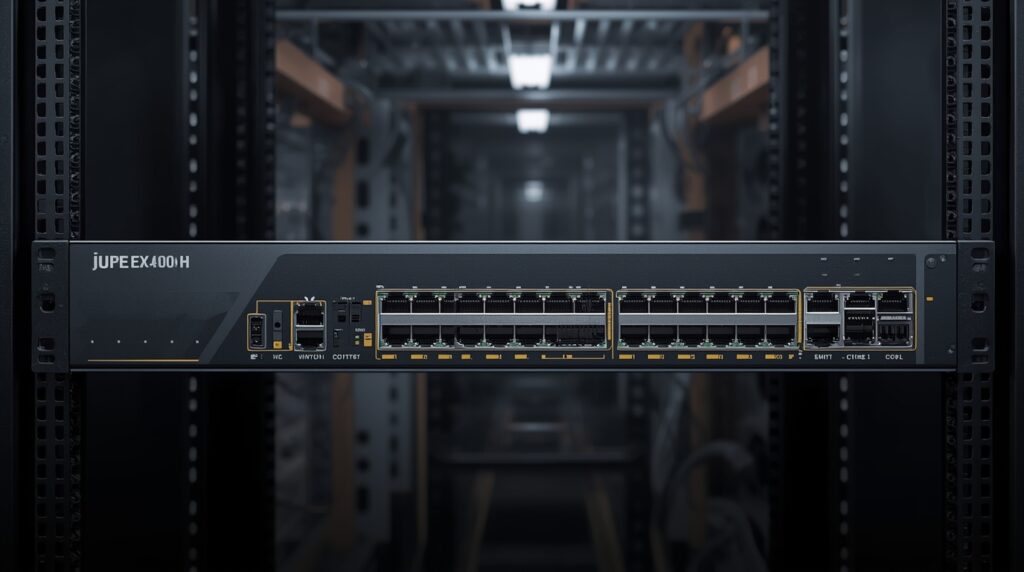Introduction
The Juniper EX4100-H Ethernet switch is a ruggedized, high-performance network solution designed for environments that demand reliability, durability, and high throughput. Ideal for industrial applications, outdoor deployments, and enterprise networks, this fanless switch combines robust hardware with advanced networking features. This guide provides a comprehensive look at EX4100-H hardware, specifications, installation, performance, comparisons, and practical deployment scenarios.
What Is the EX4100-H?
The EX4100-H is a ruggedized switch from Juniper’s EX Series, engineered for harsh environments, including industrial plants, transportation hubs, and remote outdoor locations. Unlike standard switches, it delivers:
- Fanless Operation: Reduces dust accumulation, ensures silent operation, and lowers maintenance costs.
- Wide Temperature Range: Operates reliably from -40°C to +75°C.
- Durable Construction: Resilient to vibration, shocks, and industrial wear.
- PoE++ Support: Powers devices up to 90W per port, ideal for IP cameras, access points, and industrial sensors.
These features make the EX4100-H a perfect fit for mission-critical networks where downtime is unacceptable.
Key Hardware Specifications
| Specification | EX4100-H |
|---|---|
| Ports | 12, 24, 48 |
| Uplink Ports | 10GbE SFP+ |
| PoE Support | PoE++ (up to 90W per port) |
| Redundant Power Supply | Yes |
| Operating Temperature | -40°C to +75°C |
| Mounting | 19” Rackmount |
| Switching Capacity | Up to 1.44 Tbps |
| Forwarding Rate | Up to 1.07 Bpps |
Technical Insights:
- Switching Capacity and Forwarding Rate: Handles heavy industrial and enterprise traffic with negligible latency.
- PoE++ Capability: Supports high-power devices simultaneously without performance degradation.
- Redundant Power Supplies: Ensures uninterrupted operation in critical environments.
- Fanless Design: Eliminates moving parts, reducing maintenance costs.
For official technical details, refer to the Juniper EX4100-H datasheet.
Features and Capabilities
The EX4100-H is not just rugged hardware—it offers advanced Layer 2 and Layer 3 networking capabilities:
- Layer 2 & 3 Switching: Supports VLANs, static routing, OSPF, and RIP protocols.
- Virtual Chassis Technology: Connects up to 10 switches as a single logical unit for simplified management.
- Juniper Mist AI Integration: Enables cloud-based monitoring, AI-driven insights, and automated troubleshooting.
- Security Features: MACsec AES-256 encryption, port-based access control, and storm control.
- High Availability: Redundant links, link aggregation, and failover for network reliability.
Installation and Setup
Installing the EX4100-H requires attention to hardware, network design, and software configuration.
Step 1: Unboxing and Inspection
- Confirm that all components, brackets, and documentation are present.
- Inspect the unit for physical damage.
Step 2: Rackmount Installation
- Use included brackets for mounting in a standard 19” rack.
- Ensure proper spacing for cable management and airflow.
Step 3: Power Connection
- Connect redundant power supplies.
- Verify LEDs for power, system, and PoE status.
Step 4: Network Connections
- Connect devices to the appropriate ports.
- Use uplink ports to connect to core switches or routers.
Step 5: Initial Configuration
Access CLI or web GUI to configure IP addresses, VLANs, and PoE settings:
configure
set interfaces ge-0/0/1 unit 0 family ethernet-switching vlan members VLAN10
set poe interface ge-0/0/1 admin enable
commit
Step 6: Firmware Update
- Check Juniper support portal for the latest firmware.
- Update via CLI or GUI to ensure optimal performance and security.
Real-World Tips:
- Label cables and maintain tidy racks to simplify troubleshooting.
- Ground the switch to prevent electrical damage in industrial setups.
- Avoid connecting devices exceeding PoE budget limits to prevent shutdowns.
Suggested Visuals:
- Front/rear port diagram
- Rackmount installation image
- PoE device topology diagram
Performance and Scalability
The EX4100-H is built to scale for industrial and enterprise networks:
- Throughput: Up to 1.44 Tbps supports large data flows.
- Forwarding Rate: Up to 1.07 billion packets per second.
- PoE Load: Supports high-power devices without performance loss.
- Virtual Chassis: Allows adding more switches without complex reconfiguration.
Scenario Example:
In a factory with 48 PoE devices and continuous automation traffic, the EX4100-H maintained sub-millisecond latency and stable throughput, proving its suitability for mission-critical applications.
Comparison with Other Juniper Switches
| Feature | EX4100-H | EX4300 | EX9200 |
|---|---|---|---|
| Ports | 12-48 | 24-48 | Modular |
| Uplink | 10GbE | 40GbE | 100GbE |
| PoE | PoE++ | PoE+ | Optional PoE+ |
| Fanless | Yes | No | No |
| Temperature | -40°C to +75°C | 0°C to 40°C | 0°C to 45°C |
| Power Consumption | Low | Medium | High |
| Price Range | $$-$$$ | $$$ | $$$$ |
| Pros | Rugged, outdoor-ready | High-density, enterprise | Modular, core networks |
| Cons | Limited density | Not rugged | Expensive |
Insight:
EX4100-H excels in rugged, outdoor, or industrial deployments. EX4300/EX9200 are better for high-density or modular data center setups.
Maintenance and Troubleshooting
Routine Maintenance:
- Monitor hardware via CLI, GUI, or Mist AI.
- Inspect LEDs and check PoE delivery.
- Keep firmware updated for security and performance.
Common Issues and Fixes:
- PoE Device Not Powering On: Check port configuration, cable, and power budget.
- Link Down: Verify cables, connectors, VLAN assignments.
- High CPU or Latency: Use Juniper Mist AI to identify traffic spikes or misconfigurations.
CLI Diagnostics:
show interfaces terse
show chassis hardware
show poe interface
Use Cases
- Industrial Automation: Connects sensors, PLCs, and monitoring systems.
- Transportation Hubs: Powers surveillance cameras, ticketing systems, and Wi-Fi access points.
- Remote Surveillance: Supports outdoor cameras in extreme climates.
- EV Charging Stations: Manages connectivity and PoE devices for smart charging infrastructure.
Actionable Call-to-Action
Deploy EX4100-H in your network with expert guidance from Corizonix. Contact us today for custom deployment plans, technical support, and enterprise-grade solutions tailored to your industrial or enterprise environment.
Scenario-Based FAQs
Q1: What should I do if PoE devices are not powering on?
A1: Verify port configuration, PoE budget, and cabling. Check LEDs and reboot if needed.
Q2: How can I configure EX4100-H for a remote outdoor surveillance network?
A2: Mount the switch in a weatherproof rack, enable PoE for cameras, configure VLANs for network segmentation, and monitor via Mist AI.
Q3: Can EX4100-H handle high traffic in industrial automation setups?
A3: Yes, with switching capacity up to 1.44 Tbps and sub-millisecond latency under full load.
Q4: How to perform firmware upgrades safely in high-availability environments?
A4: Upgrade one switch at a time in a Virtual Chassis setup, ensuring failover redundancy is active.
Q5: How to integrate EX4100-H with Juniper Mist AI for monitoring?
A5: Register the switch with Mist AI cloud, configure SNMP and alerts, and monitor performance dashboards in real-time.

